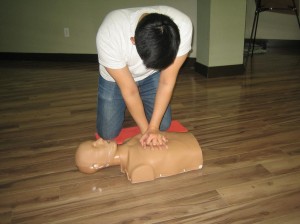Honolulu CPR has several courses on CPR and first aid. We have eight total programs, divided into basic, advanced, and re-certification training. Because we are dedicated to providing quality training to a wide range of students, we keep our training fees and course rates very affordable. There are many providers that offer high quality training in Hawaii but none that offer as affordable training as we do. We also have five other locations in the United States, offering the same set of courses.
Certificates
All of the courses are certification courses. That means that once the student completes the enrolled program with full attendance and a pass on the post-test, he or she is awarded with a training certificate that is valid for 24 months. We instruct our students to renew their certificates before the expiration date, or else they won’t be eligible for the shorter, re-certification classes.
The deal with AEDs

In the guidelines created by the American Heart Association for giving CPR, the third step is rapid defibrillation. What is defibrillation? Defibrillation is the use of electricity to restore normal cardiac rhythm. What people usually see in movies and on TV is defibrillation being done when a victim’s rhythm is flat or asystole. This is incorrect; defibrillation is done during severe cardiac arhrythmias – such as ventricular fibrillation (V-fib).
In order to perform defibrillation, an AED is used – automated external defibrillator – to send electricity through wires and pads attached to the chest which then reaches the heart. The electricity restores the cardiac rhythm to normal sinus rhythm. AEDs are usually found in most public places such as malls and community centers, and of course with emergency medical rescuers.
Why learning CPR should be important to you
Every year, more than half a million Americans die because of heart problems. Roughly a third to half of that is because of cardiac arrest. Cardiovascular disease (CVDs) kill so many people each year but they are very easy to prevent. Giving CPR is also pretty simple – yet most bystanders are uncomfortable in giving compressions. CPR is very important within the first few minutes of cardiac arrest. Being able to provide compressions and ventilation can mean the difference between life and death for a victim, if done correctly and timely.
Almost 70 percent of bystanders are too scared to help with compressions. Yet, millions of people are trained each year to give CPR. Remember, you can save a life with your skills and you should never be afraid to lend a helping hand.
Remember these simple tips when managing cardiac arrest:
- If a person loses consciousness and is unresponsive, immediately assume that he or she is experiencing cardiac arrest.
- Immediately call for help or have someone call the emergency number.
- Push hard and fast in the middle of the chest but allow the chest to recoil between each compression.
